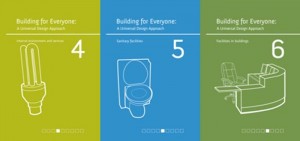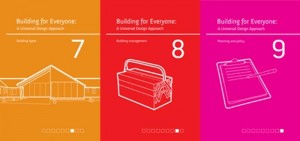BOOK LAUNCH : BUILDING FOR EVERYONE
February the 23rd was a busy day for the fairly tidy world of Irish architectural publishing, with Slow Architecture and Place launched that evening, and Building for Everyone appearing in the early afternoon. Minister Phil Hogan was on hand to begin the formalities, and remind us of the progress of the government in building regulation – particularly referring to the recent amendment of Part M – now, much more sensibly, titled Access and Use.
The new Building for Everyone replaces the 2002 edition, which, as architect and RIAI president Michelle Fagan pointed out from her own experience, was never available on the office shelf and always at somebody’s desk. It has been in development for over 3 years by the Centre for Excellence in Universal Design, principally by Neil Murphy, their senior built environment advisor , and director Dr Ger Craddock. There were scores of individuals and bodies involved in helping this guide to get to publication – even I worked on the edges of it, comparing its guidance to the new Part M and legislation from other jurisdictions.
The big advantage of this guide is the comprehensive guidance it offers. This book seeks to help building professionals undertake a Universal Design approach to building design, an approach that looks to go beyond legislative minimums and to fully include the needs of all people, regardless of their age, size, or ability, as far as this is possible. It offers guidance on all areas of buildings, and explains what this advice is reflecting, and who is being considered.
The book has now become a series – there are nine booklets dealing with different building types and aspects of the building process – this includes a booklet dedicated to an inclusive approach to the planning process. Areas around buildings and streetscapes, as well as some observations on routes through landscape, are detailed here. The series examines and offers specific advice upon how people get into buildings; how they orient themselves within buildings; how they might circulate around them; how people access the various facilities a building, and then goes into detail on a range of facilities include toilet and changing areas, food preparation and dining areas, auditoria and sleeping areas.
Building for Everyone separates approaches for different building types (in Booklet 7), including single dwellings and more public buildings, and even deals with how buildings can effectively be managed – one of the most difficult and disheartening aspects of creating inclusive buildings is realising that the design strategies are severely undermined by the way the spaces and building services are being used and maintained.
There is an acceptance that Universal Design is a process in itself – the authors have committed to updating Building for Everyone in its pdf edition regularly, in response to new research and input from different building users and advocates.
The full series of books deals with:
- External environment
- Entrances and Horizontal Circulation
- Vertical Circulation
- Internal Environment and Services
- Sanitary Facilities
- Facilities
- Building Types
- Building Management
- Planning
- Index and Terminology
- Entire Series; Booklets 1 – 10
It is available for free online, or a printed edition is available – for information on the print edition and availability contact the Centre for Excellence in Universal Design. Make sure you have enough room on your shelf though, there are almost a thousand pages to fit!




